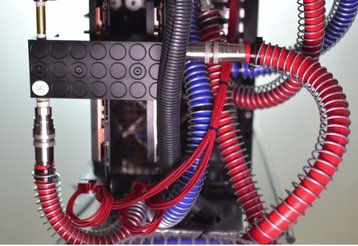New York-based inventor and engineer Lawrence Orsini has proposed installing distributed supercomputers in domestic property that will provide heat, while also handling cloud computing tasks.
Project Exergy, which held its launch event on 1February, wants to raise $100,000 on crowdfunding site Kickstarter and promises to solve home heating bills and data center real estate costs by distributing computing tasks to servers located in homes and offices, where their waste heat can be used to heat the building.
If that sounds familiar, DatacenterDnamics readers have already met two European projects promising to do exactly this. Datacenter Dynamics spoke to Orsini - and he assured us that he is well aware of the European projects, but has distinct design goals of his own.
Burning fuel only once
Orsini has built a prototype called Henry, essentially a very fancy PC which swaps cooling fans for a more efficient system of heat exchange, and feeds warm air into a heating system. According to the plans outlined by Orsini’s Project Exergy promotional video, homes and apartment blocks will become the hosts for “the computation that would otherwise take place in data centers.”
Orsini’s prototype systems would be used to ‘power the cloud’ and run everything from cell texts to live TV streaming, while making better use of the 60% of the input energy that is used for cooling in data centers.
Every megabyte of data consumed is the equivalent of burning of one charcoal briquette, claims Project Exergy’s publicity campaign. The project aims to use that heat, so people don’t burn the equivalent of another briquette warming their homes. Project Exergy is looking for further funding from a Kickstarter that aims to raise US$100,000 (with a “stretch” goal of $2 million).
The project is the latest in a number of similar initiatives to close the circle on heat waste from computing and energy consumption for domestic heating - and two European projects are furether developed, with actual heaters installed in homes and offices.
Europe does it first?
French company Qarnot and Germany’s Cloud&Heat have both developed offerings that aim to recycle energy. Cloud&Heat, based in Germany, offers free hot water to companies that agree to host elements of a distributed data center (namely servers) within their premises. While the servers process data for Cloud&Heat’s clients, the energy dissipated is used to heat the host’s building. The logic of the deal is that cloud customers get cheap pay-per-use computing service (based on OpenStack) while the hosts save money on heating.
In France Qarnot is offering domestic heating with a wall-mounted four-processor radiator more suitable for the home environment. Qarnot’s version of the concept uses more specialised supercomputing tasks, including image processing for movies.
Orsini spoke to Datacenter Dynamics and told uas that his systems will be configured to extract the maximum heat by running the processors at a higher temperature: “By designing a computer to work hard all the time and to get its processors hot while doing so, we have created an extremely efficient source of heat and have significantly reduced energy wastage and energy bills,” said Orsini.
In future, Exergy hopes to use specially designed high-termperature chips that operate at temperatures up to 250F, which will allow for more efficient and re-usable heat in the form of very hot water.
The video of Henry appears to show a system which has been configured with multiple GPUs which any home hardware enthusiast knows will run at high temperatures. The press materials claim that Henry reclaims 70 percent of the heat generated, and promise that a second beta product will increase this to 90 percent.
As well as the Henry prototype there is also a prototype of a heat storage system called the Thermal Pig. This stores water in a hot water tank - and a future version will use a phase change material to store the heat.
The second beta of the system itself exists as a concept image, of a shiny cylinder, but there are indications that it will move from air cooling to liquid cooling, essentially immersing the computer in inert coolant, which companies such as Iceotope have found to be more efficient at removing heat.
Exergy’s prototype heating and storage systems generated a lot of excess heat, and the group knocked up a system that vented that heat through a heat exchanger in the water cistern of a toilet. This ”commode cooler” appeared on the Exergy site, but Orsini told Datacenter Dynamics that it wouldn’t form part of any production system - as the whole point of the project is to find a use for the heat, not to vent it.
At this stage, we have yet to hear directly from Exergy, but look forward to hearing more.
“We have the vision, we just need funding to build a second prototype,” said Orsini in his Kickstarter campaign video.

